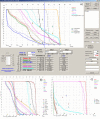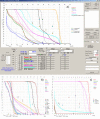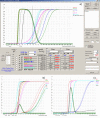IsoBED: a tool for automatic calculation of biologically equivalent fractionation schedules in radiotherapy using IMRT with a simultaneous integrated boost (SIB) technique
- PMID: 21554675
- PMCID: PMC3117739
- DOI: 10.1186/1756-9966-30-52
IsoBED: a tool for automatic calculation of biologically equivalent fractionation schedules in radiotherapy using IMRT with a simultaneous integrated boost (SIB) technique
Abstract
Background: An advantage of the Intensity Modulated Radiotherapy (IMRT) technique is the feasibility to deliver different therapeutic dose levels to PTVs in a single treatment session using the Simultaneous Integrated Boost (SIB) technique. The paper aims to describe an automated tool to calculate the dose to be delivered with the SIB-IMRT technique in different anatomical regions that have the same Biological Equivalent Dose (BED), i.e. IsoBED, compared to the standard fractionation.
Methods: Based on the Linear Quadratic Model (LQM), we developed software that allows treatment schedules, biologically equivalent to standard fractionations, to be calculated. The main radiobiological parameters from literature are included in a database inside the software, which can be updated according to the clinical experience of each Institute. In particular, the BED to each target volume will be computed based on the alpha/beta ratio, total dose and the dose per fraction (generally 2 Gy for a standard fractionation). Then, after selecting the reference target, i.e. the PTV that controls the fractionation, a new total dose and dose per fraction providing the same isoBED will be calculated for each target volume.
Results: The IsoBED Software developed allows: 1) the calculation of new IsoBED treatment schedules derived from standard prescriptions and based on LQM, 2) the conversion of the dose-volume histograms (DVHs) for each Target and OAR to a nominal standard dose at 2Gy per fraction in order to be shown together with the DV-constraints from literature, based on the LQM and radiobiological parameters, and 3) the calculation of Tumor Control Probability (TCP) and Normal Tissue Complication Probability (NTCP) curve versus the prescribed dose to the reference target.
Figures







Similar articles
-
Simultaneous integrated intensity-modulated radiotherapy boost for locally advanced gynecological cancer: radiobiological and dosimetric considerations.Int J Radiat Oncol Biol Phys. 2005 Jul 1;62(3):933-9. doi: 10.1016/j.ijrobp.2004.11.040. Int J Radiat Oncol Biol Phys. 2005. PMID: 15936580
-
Radiobiological considerations in the design of fractionation strategies for intensity-modulated radiation therapy of head and neck cancers.Int J Radiat Oncol Biol Phys. 2000 Feb 1;46(3):619-30. doi: 10.1016/s0360-3016(99)00438-1. Int J Radiat Oncol Biol Phys. 2000. PMID: 10701741
-
Myths, facts and scope of spinal cord tolerance dose revision in Intensity modulated SIB treatment of locally advanced head and neck cancer: A dosimetrical and radiobiological demonstration.Cancer Radiother. 2021 Feb;25(1):8-12. doi: 10.1016/j.canrad.2020.05.015. Epub 2020 Dec 5. Cancer Radiother. 2021. PMID: 33293203
-
Radiobiological basis and clinical results of the simultaneous integrated boost (SIB) in intensity modulated radiotherapy (IMRT) for head and neck cancer: A review.Crit Rev Oncol Hematol. 2010 Feb;73(2):111-25. doi: 10.1016/j.critrevonc.2009.03.003. Epub 2009 May 5. Crit Rev Oncol Hematol. 2010. PMID: 19409808 Review.
-
The linear-quadratic transformation of dose-volume histograms in fractionated radiotherapy.Radiother Oncol. 1998 Mar;46(3):285-95. doi: 10.1016/s0167-8140(97)00162-x. Radiother Oncol. 1998. PMID: 9572622 Review.
Cited by
-
Dosimetric and clinical advantages of deep inspiration breath-hold (DIBH) during radiotherapy of breast cancer.J Exp Clin Cancer Res. 2013 Nov 7;32(1):88. doi: 10.1186/1756-9966-32-88. J Exp Clin Cancer Res. 2013. PMID: 24423396 Free PMC article.
-
Cerebral Cortex Regions Selectively Vulnerable to Radiation Dose-Dependent Atrophy.Int J Radiat Oncol Biol Phys. 2017 Apr 1;97(5):910-918. doi: 10.1016/j.ijrobp.2017.01.005. Epub 2017 Jan 6. Int J Radiat Oncol Biol Phys. 2017. PMID: 28333012 Free PMC article.
-
Retrospective analysis of fractionated intensity-modulated radiotherapy (IMRT) in the interdisciplinary management of primary optic nerve sheath meningiomas.Radiat Oncol. 2019 Dec 27;14(1):240. doi: 10.1186/s13014-019-1438-2. Radiat Oncol. 2019. PMID: 31881902 Free PMC article.
-
Regional susceptibility to dose-dependent white matter damage after brain radiotherapy.Radiother Oncol. 2017 May;123(2):209-217. doi: 10.1016/j.radonc.2017.04.006. Epub 2017 May 2. Radiother Oncol. 2017. PMID: 28460824 Free PMC article.
-
Radiotherapy for HER 2 Positive Brain Metastases: Urgent Need for a Paradigm Shift.Cancers (Basel). 2022 Mar 15;14(6):1514. doi: 10.3390/cancers14061514. Cancers (Basel). 2022. PMID: 35326665 Free PMC article. Review.
References
-
- Ang KK, Peters LJ. Concomitant boost radiotherapy in the treatment of head and neck cancer. Semin Radiat Oncol. 1992;2:31–33. doi: 10.1016/S1053-4296(05)80049-9. - DOI
MeSH terms
LinkOut - more resources
Full Text Sources

